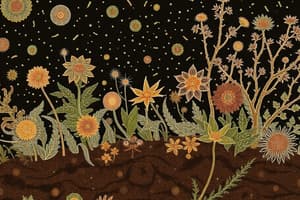Podcast
Questions and Answers
What is the primary focus of soil microbiology?
What is the primary focus of soil microbiology?
- Soil erosion
- Soil chemical reactions
- Soil-inhabiting microorganisms (correct)
- Soil geological formation
What is the characteristic of soil that allows it to harbor a diverse range of microorganisms?
What is the characteristic of soil that allows it to harbor a diverse range of microorganisms?
- Chemical and physical homogeneity
- Absence of water
- Chemical and physical heterogeneity (correct)
- Uniformity in nutrients
How many categories of microorganisms are found in soil?
How many categories of microorganisms are found in soil?
- 3
- 5
- 7 (correct)
- 10
What is the role of microorganisms in soil?
What is the role of microorganisms in soil?
What is a characteristic feature of microorganisms in soil?
What is a characteristic feature of microorganisms in soil?
What is the depth range of microorganisms found in soil?
What is the depth range of microorganisms found in soil?
What is the typical cell shape of bacteria found in soil?
What is the typical cell shape of bacteria found in soil?
Where are most bacteria found in soil?
Where are most bacteria found in soil?
What is a characteristic of bacteria in the rhizosphere compared to those in bulk soil?
What is a characteristic of bacteria in the rhizosphere compared to those in bulk soil?
What is one of the ecosystem services provided by soil bacterial communities?
What is one of the ecosystem services provided by soil bacterial communities?
Which of the following genera is NOT typically found in soil?
Which of the following genera is NOT typically found in soil?
What is the size range of bacteria in soil?
What is the size range of bacteria in soil?
What is the primary function of the polysaccharides and glycoproteins produced by bacteria in the soil?
What is the primary function of the polysaccharides and glycoproteins produced by bacteria in the soil?
What is the role of bacteria in the biogeochemical cycles?
What is the role of bacteria in the biogeochemical cycles?
What is the effect of bacterial communities on soil condition?
What is the effect of bacterial communities on soil condition?
What is the result of pathogenic bacteria in the soil?
What is the result of pathogenic bacteria in the soil?
What is the effect of bacterial by-products on soil properties?
What is the effect of bacterial by-products on soil properties?
What is a negative impact of some bacteria on the soil?
What is a negative impact of some bacteria on the soil?
Flashcards
Soil Microbiology
Soil Microbiology
A branch of soil science focusing on microorganisms in soil, their roles, and activities.
Soil Habitat
Soil Habitat
A diverse environment with varying conditions that support the growth of microorganisms.
Role of Soil Microorganisms
Role of Soil Microorganisms
Microorganisms in soil perform various metabolic processes that are key for nutrient cycling.
Biodegradation of Pollutants
Biodegradation of Pollutants
Signup and view all the flashcards
Soil Substrates
Soil Substrates
Signup and view all the flashcards
Biodiversity of Soil Microorganisms
Biodiversity of Soil Microorganisms
Signup and view all the flashcards
Classification of Soil Microorganisms
Classification of Soil Microorganisms
Signup and view all the flashcards
Bacteria
Bacteria
Signup and view all the flashcards
Rhizosphere
Rhizosphere
Signup and view all the flashcards
Biogeochemical Cycles
Biogeochemical Cycles
Signup and view all the flashcards
Soil Structure Enhancement
Soil Structure Enhancement
Signup and view all the flashcards
Soil Health Indicators
Soil Health Indicators
Signup and view all the flashcards
Pathogenic Bacteria
Pathogenic Bacteria
Signup and view all the flashcards
Ecological Imbalance
Ecological Imbalance
Signup and view all the flashcards
Soil Chemistry Alteration
Soil Chemistry Alteration
Signup and view all the flashcards
Types of Soil Microbes
Types of Soil Microbes
Signup and view all the flashcards
Ecosystem Services
Ecosystem Services
Signup and view all the flashcards
Study Notes
Soil Microbiology Overview
- A branch of soil science focused on microorganisms in soil, their functions, and activities.
- Soil is a diverse habitat with dynamic environmental conditions conducive to microbial growth.
Role of Soil Microorganisms
- Soil harbors vast numbers of microorganisms with diverse metabolic activities essential for nutrient cycling.
- Microorganisms play a crucial role in the biodegradation of pollutants and improving soil health.
- Soil contains various substrates ranging from simple sugars to complex compounds like humus.
Diversity and Classification
- High environmental heterogeneity results in significant biodiversity among soil microorganisms.
- Microorganisms are classified into seven groups: bacteria, fungi, viruses, blue-green algae, actinomycetes, protozoa, and nematodes.
- These groups display unique characteristics and roles in their respective niches within the soil.
Bacteria in Soil
- Bacteria are prokaryotic, typically 0.5 to 1 mm in width and 1 to 2 mm in length, with diverse shapes including rod, spherical, spiral, and filamentous.
- They are abundant, particularly in the rhizosphere, which supports plant health through various functions.
- Major genera include Bacillus, Pseudomonas, Agrobacterium, and Clostridium.
Positive Contributions of Bacteria
- Vital for biogeochemical cycles, particularly nitrogen and carbon cycles, producing nutrients essential for plants.
- Enhance soil structure by producing polysaccharides and glycoproteins that bind soil particles together.
- Act as indicators of soil health and help improve soil quality for new plant communities.
Negative Effects of Bacteria
- Pathogenic bacteria can harm crops, causing reduced yields and crop loss.
- Some bacteria disrupt ecological balance, leading to soil infertility and diminished soil health.
- By-products of bacterial activity can alter soil chemistry, impacting pH and nutrient content.
Types of Soil Microbes
- Five main types of soil microbes: bacteria, actinomycetes, fungi, protozoa, and nematodes, each playing distinct roles in soil and plant health.
- Soil bacterial communities provide ecosystem services that enhance soil function and support plant growth.
Studying That Suits You
Use AI to generate personalized quizzes and flashcards to suit your learning preferences.




